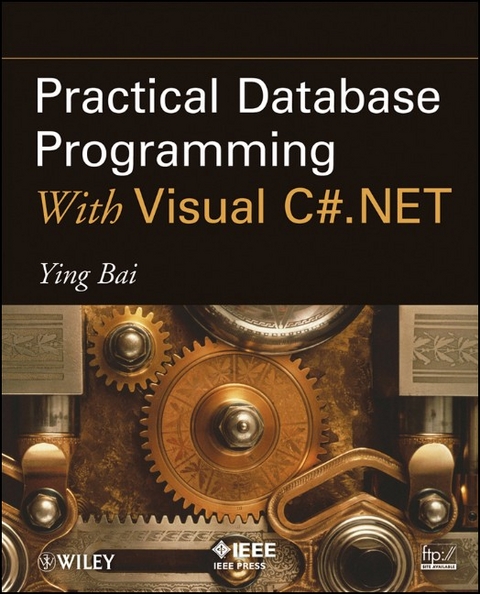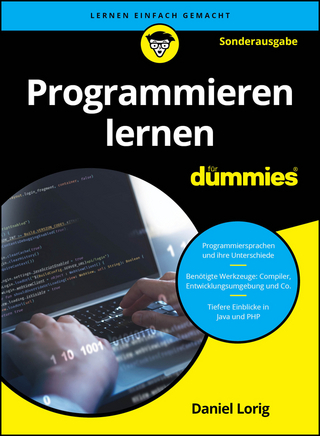
Practical Database Programming With Visual C#.NET
Wiley-IEEE Press (Verlag)
978-0-470-46727-5 (ISBN)
- Lieferbar (Termin unbekannt)
- Versandkostenfrei
- Auch auf Rechnung
- Artikel merken
A novel approach to developing and applying databases with Visual C#.NET Practical Database Programming with Visual C#.NET clearly explains the considerations and applications in database programming with Visual C#.NET 2008 and in developing relational databases such as Microsoft Access, SQL Server, and Oracle Database. Sidestepping the traditional approach of using large blocks of code, Ying Bai utilizes both Design Tools and Wizards provided by Visual Studio.NET and real-time object methods to incorporate over sixty real sample database programming projects along with detailed illustrations and explanations to help readers understand the key techniques and programming technologies in database programming. This invaluable resource features:
Fundamental and advanced database programming techniques for beginning and experienced students as well as programmers
A real completed sample database CSE_DEPT with three versions (Microsoft Access 2007, SQL Server 2005 SP2, and Oracle Database 10g XE Release 2) used throughout the entire book
Step-by-step details on designing and building a practical relational database
Discussion and analysis of the new database query technique, LINQ API—which includes LINQ to Objects, LINQ to DataSet, LINQ to SQL, LINQ to Entities, and LINQ to XML—and implementation in actual projects with line-by-line explanation
Homework and selected solutions for each chapter to strengthen and improve learning and understanding
An Instructor's Manual (MS PPT), example codes and exercise questions, homework/exercise solutions, and database projects available for free download
E-mail assistance from the author
Readers who will benefit highly from this reference are undergraduate or graduate students majoring in computer science and engineering, graduate students in all engineering departments, and software engineers and researchers in academic and industrial fields.
To obtain instructor materials please send an email to pressbooks@ieee.org
Note: CD-ROM/DVD and other supplementary materials are not included as part of eBook file.
Dr. Ying Bai is an Associate Professor in the Department of Computer Science and Engineering at Johnson C. Smith University (JCSU). Before joining JCSU, Dr. Bai worked as a senior software engineer in the field of automatic control and testing equipment in Silicon Valley, California, and Columbus, Ohio. He has a great deal of experience in robotics control, robot calibrations, and related software programming, as well as accurate measurements in industrial and academic fields. Dr. Bai is a Senior Member of IEEE and a member of ACM. In recent years, he has published six books in multi-language interface programming, serial port programming, electronics, fuzzy logic technology, and database programming with Visual Basic.NET.
Preface. Acknowledgment.
1 Introduction.
Outstanding Features of the Book.
Target Audience.
Topics Covered.
Organization of the Book and How to Use It.
How to Use the Source Code and Sample Databases.
Instructor and Customer Support.
Homework Solutions.
2 Introduction to Databases.
2.1 What Are Databases and Database Programs?
2.2 Develop a Database.
2.3 Sample Database.
2.4 Identifying Keys.
2.5 Defi ne Relationships.
2.6 ER Notation.
2.7 Data Normalization.
2.8 Database Components in Some Popular Databases.
2.9 Create Microsoft Access Sample Database.
2.10 Create Microsoft SQL Server 2005 Sample Database.
2.11 Create Oracle 10g XE Sample Database.
2.12 Chapter Summary.
Homework.
3 Introduction to ADO.NET.
3.1 ADO and ADO.NET.
3.2 Overview of ADO.NET 2.0.
3.3 Architecture of ADO.NET 2.0.
3.4 Components of ADO.NET 2.0.
3.5 Chapter Summary.
Homework.
4 Introduction to Language-Integrated Query (LINQ).
4.1 Overview of Language-Integrated Query.
4.2 Introduction to LINQ Query.
4.3 Architecture and Components of LINQ.
4.4 LINQ to Objects.
4.5 LINQ to DataSet.
4.6 LINQ to SQL.
4.7 LINQ to Entities.
4.8 LINQ to XML.
4.9 C# 3.0 Language Enhancement for LINQ.
4.10 Chapter Summary.
Homework.
5 Data Selection Query with Visual C#.NET.
PART I Data Query with Visual Studio Design Tools and Wizards.
5.1 Completed Sample Database Application Example.
5.2 Visual Studio.NET 2008 Design Tools and Wizards.
5.3 Build a Sample Database Project—SelectWizard with SQL Server Database.
5.4 Add and Utilize Visual Studio.NET Wizards and Design Tools.
5.5 Query and Display Data Using the DataGridView Control.
5.6 Use DataSet Designer to Edit the Structure of DataSet.
5.7 Bind Data to Associated Controls in LogIn Form.
5.8 Develop Codes to Query Data Using Fill() Method.
5.9 Use Return a Single Value to Query Data for LogIn Form.
5.10 Coding for Selection Form.
5.11 Bind Data to Associated Controls in Faculty Form.
5.12 Develop Codes to Query Data from Faculty Table.
5.13 Display Pictures for Faculty Form.
5.14 Binding Data to Associated Controls in Course Form.
5.15 Develop Codes to Query Data for Course Form.
5.16 Build a Sample Database Project—SelectWizardOracle with Oracle Database.
PART II Data Query with Runtime Objects.
5.17 Introduction to Runtime Objects.
5.18 Query Data Using Runtime Objects to Microsoft Access 2007 Database.
5.19 Query Data Using Runtime Objects to SQL Server Database.
5.20 Query Data Using Runtime Objects to Oracle Database.
5.21 Chapter Summary.
Homework.
6 Data Inserting with Visual C#.NET.
PART I Data Inserting with Visual Studio.NET Design Tools and Wizards.
6.1 Insert New Data into a Database.
6.2 Insert Data into Microsoft Access Database Using Sample Project InsertWizard.
6.3 Insert Data into SQL Server Database Using Sample Project SQLInsertWizard.
6.4 Insert Data into Oracle Database Using Sample Project OracleInsertWizard.
PART II Data Insertion with Runtime Objects.
6.5 General Runtime Objects Method.
6.6 Insert Data into SQL Server Database Using Runtime Objects Method.
6.7 Insert Data into Microsoft Access Database Using Runtime Objects.
6.8 Insert Data into Oracle Database Using Runtime Objects.
6.9 Insert Data into Database Using LINQ Queries.
6.10 Insert Data into Database Using Stored Procedures.
6.11 Chapter Summary.
Homework.
7 Data Updating and Deleting with Visual C#.NET.
PART I Data Updating and Deleting with Visual Studio.NET Design Tools and Wizards.
7.1 Update or Delete Data in Databases.
7.2 Update and Delete Data for Microsoft Access Database.
7.3 Update and Delete Data for SQL Server Database.
7.4 Update and Delete Data for Oracle Database.
PART II Data Updating and Deleting with Runtime Objects.
7.5 Runtime Objects Method.
7.6 Update and Delete Data for SQL Server Database Using Runtime Objects.
7.7 Update and Delete Data for Oracle Databases Using Runtime Objects.
7.8 Update and Delete Data in Database Using Stored Procedures.
7.9 Update and Delete Data in Databases Using LINQ to SQL Query.
7.10 Chapter Summary.
Homework.
8 Accessing Data in ASP.NET.
8.1 What Is .NET Framework?
8.2 What Is ASP.NET and ASP.NET 3.5?
8.3 Develop ASP.NET Web Application to Select Data from SQL Server Databases.
8.4 Develop ASP.NET Web Application to Insert Data into SQL Server Databases.
8.5 Develop Web Applications to Update and Delete Data in SQL Server Databases.
8.6 Develop ASP.NET Web Applications with LINQ to SQL Query.
8.7 Develop ASP.NET Web Application to Select Data from Oracle Databases.
8.8 Develop ASP.NET Web Application to Insert Data into Oracle Databases.
8.9 Develop ASP.NET Web Application to Update and Delete Data in Oracle Databases.
8.10 Chapter Summary.
Homework.
9 ASP.NET Web Services.
9.1 Web Services and Their Components.
9.2 Procedures to Build a Web Service.
9.3 Build ASP.NET Web Service Projects to Access SQL Server Database.
9.4 Build ASP.NET Web Service Project to Insert Data into SQL Server Database.
9.5 Build ASP.NET Web Service to Update and Delete Data for SQL Server Database.
9.6 Build Windows-Based Web Service Clients to Use Web Services.
9.7 Build Web-Based Web Service Clients to Use Web Services.
9.8 Build ASP.NET Web Service Project to Access Oracle Database.
9.9 Build Web Service Clients to Use the Web Service WebServiceOracleSelect.
9.10 Build ASP.NET Web Service Project to Insert Data into Oracle Database.
9.11 Build Web Service Clients to Use Web Service WebServiceOracleInsert.
9.12 Build ASP.NET Web Service to Update and Delete Data for Oracle Database.
9.13 Build Web Service Clients to Use Web Service.
9.14 Chapter Summary.
Homework.
Index.
About the Author.
| Zusatzinfo | Screen captures: 600 B&W, 0 Color |
|---|---|
| Sprache | englisch |
| Maße | 188 x 234 mm |
| Gewicht | 1610 g |
| Themenwelt | Mathematik / Informatik ► Informatik ► Programmiersprachen / -werkzeuge |
| Mathematik / Informatik ► Informatik ► Software Entwicklung | |
| ISBN-10 | 0-470-46727-4 / 0470467274 |
| ISBN-13 | 978-0-470-46727-5 / 9780470467275 |
| Zustand | Neuware |
| Informationen gemäß Produktsicherheitsverordnung (GPSR) | |
| Haben Sie eine Frage zum Produkt? |
aus dem Bereich


